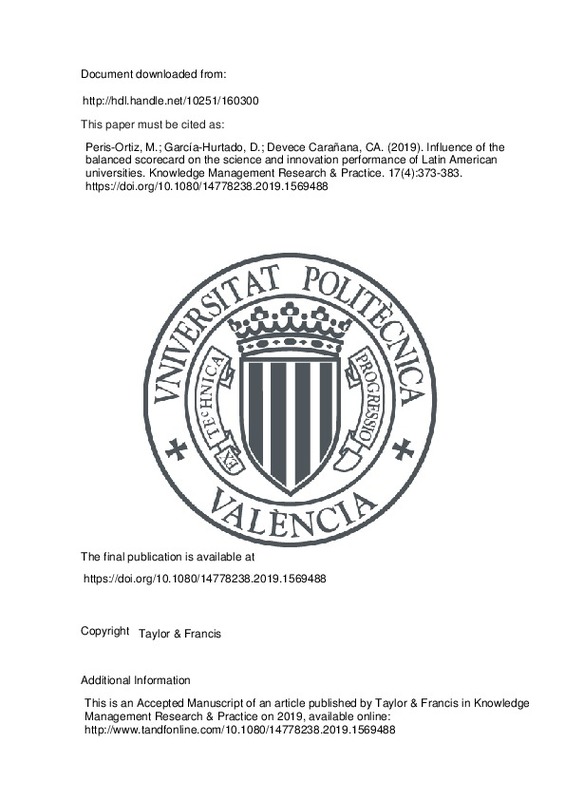Agostino, D., & Arnaboldi, M. (2012). Design issues in Balanced Scorecards: The «what» and «how» of control. European Management Journal, 30(4), 327-339. doi:10.1016/j.emj.2012.02.001
Al-Ashaab, A., Flores, M., Doultsinou, A., & Magyar, A. (2011). A balanced scorecard for measuring the impact of industry–university collaboration. Production Planning & Control, 22(5-6), 554-570. doi:10.1080/09537287.2010.536626
Ankrah, S., & AL-Tabbaa, O. (2015). Universities–industry collaboration: A systematic review. Scandinavian Journal of Management, 31(3), 387-408. doi:10.1016/j.scaman.2015.02.003
[+]
Agostino, D., & Arnaboldi, M. (2012). Design issues in Balanced Scorecards: The «what» and «how» of control. European Management Journal, 30(4), 327-339. doi:10.1016/j.emj.2012.02.001
Al-Ashaab, A., Flores, M., Doultsinou, A., & Magyar, A. (2011). A balanced scorecard for measuring the impact of industry–university collaboration. Production Planning & Control, 22(5-6), 554-570. doi:10.1080/09537287.2010.536626
Ankrah, S., & AL-Tabbaa, O. (2015). Universities–industry collaboration: A systematic review. Scandinavian Journal of Management, 31(3), 387-408. doi:10.1016/j.scaman.2015.02.003
Broadbent, J., & Laughlin, R. (2009). Performance management systems: A conceptual model. Management Accounting Research, 20(4), 283-295. doi:10.1016/j.mar.2009.07.004
Chen, S., Yang, C., & Shiau, J. (2006). The application of balanced scorecard in the performance evaluation of higher education. The TQM Magazine, 18(2), 190-205. doi:10.1108/09544780610647892
Ferreira, A., & Otley, D. (2009). The design and use of performance management systems: An extended framework for analysis. Management Accounting Research, 20(4), 263-282. doi:10.1016/j.mar.2009.07.003
Franceschini, F., & Turina, E. (2011). Quality improvement and redesign of performance measurement systems: an application to the academic field. Quality & Quantity, 47(1), 465-483. doi:10.1007/s11135-011-9530-1
Gibbert, M., Ruigrok, W., & Wicki, B. (2008). What passes as a rigorous case study? Strategic Management Journal, 29(13), 1465-1474. doi:10.1002/smj.722
Ittner, C. D., Larcker, D. F., & Randall, T. (2003). Performance implications of strategic performance measurement in financial services firms. Accounting, Organizations and Society, 28(7-8), 715-741. doi:10.1016/s0361-3682(03)00033-3
Kaplan, R. S., & Norton, D. P. (2001). Transforming the Balanced Scorecard from Performance Measurement to Strategic Management: Part II. Accounting Horizons, 15(2), 147-160. doi:10.2308/acch.2001.15.2.147
Khalid, S., Knouzi, N., Tanane, O., & Talbi, M. (2014). Balanced Scoreboard, the Performance Tool in Higher Education: Establishment of Performance Indicators. Procedia - Social and Behavioral Sciences, 116, 4552-4558. doi:10.1016/j.sbspro.2014.01.984
Kraus, K., & Lind, J. (2010). The impact of the corporate balanced scorecard on corporate control—A research note. Management Accounting Research, 21(4), 265-277. doi:10.1016/j.mar.2010.08.001
Langfield-Smith, K. (1997). Management control systems and strategy: A critical review. Accounting, Organizations and Society, 22(2), 207-232. doi:10.1016/s0361-3682(95)00040-2
Lawrence, S., & Sharma, U. (2002). Commodification of Education and Academic LABOUR—Using the Balanced Scorecard in a University Setting. Critical Perspectives on Accounting, 13(5-6), 661-677. doi:10.1006/cpac.2002.0562
Lee, B., Collier, P. M., & Cullen, J. (2007). Reflections on the use of case studies in the accounting, management and organizational disciplines. Qualitative Research in Organizations and Management: An International Journal, 2(3), 169-178. doi:10.1108/17465640710835337
Neely, A., Gregory, M., & Platts, K. (1995). Performance measurement system design. International Journal of Operations & Production Management, 15(4), 80-116. doi:10.1108/01443579510083622
Philbin, S. (2008). Process model for university‐industry research collaboration. European Journal of Innovation Management, 11(4), 488-521. doi:10.1108/14601060810911138
Pritchard, R. D., Roth, P. L., Jones, S. D., & Roth, P. G. (1990). Implementing feedback systems to enhance productivity: A practical guide. National Productivity Review, 10(1), 57-67. doi:10.1002/npr.4040100107
Ridwan, R., Harun, H., An, Y., & Fahmid, I. M. (2013). The Impact of the Balanced Scorecard on Corporate Performance: The Case of an Australian Public Sector Enterprise. International Business Research, 6(10). doi:10.5539/ibr.v6n10p103
Sayed, N. (2013). Ratify, reject or revise: balanced scorecard and universities. International Journal of Educational Management, 27(3), 203-220. doi:10.1108/09513541311306440
Spender, J.-C. (2014). Business Strategy. doi:10.1093/acprof:oso/9780199686544.001.0001
Tangen, S. (2005). Analysing the requirements of performance measurement systems. Measuring Business Excellence, 9(4), 46-54. doi:10.1108/13683040510634835
Villarreal Larrinaga, O., & Landeta Rodríguez, J. (2010). EL ESTUDIO DE CASOS COMO METODOLOGÍA DE INVESTIGACIÓN CIENTÍFICA EN DIRECCIÓN Y ECONOMÍA DE LA EMPRESA. UNA APLICACIÓN A LA INTERNACIONALIZACIÓN. Investigaciones Europeas de Dirección y Economía de la Empresa, 16(3), 31-52. doi:10.1016/s1135-2523(12)60033-1
Wiersma, E. (2009). For which purposes do managers use Balanced Scorecards? Management Accounting Research, 20(4), 239-251. doi:10.1016/j.mar.2009.06.001
[-]







![[Cerrado]](/themes/UPV/images/candado.png)


